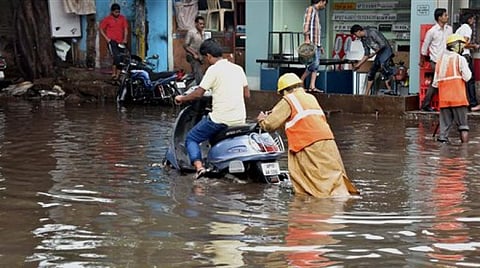

A city paralysed – flooded streets, giant craters on the road, power shutdowns owing to fears of electrocution, the National Disaster Response Force carrying out relief and rescue operations. Chennai in December 2015, Bengaluru in July 2016 and now Hyderabad. It’s a grim but predictable story playing out across South India’s biggest cities.
“Brand Chennai takes a beating,” screamed one headline after the December floods crippled life and industry in Tamil Nadu’s capital – the auto manufacturing hub of India. While the automobile industry reportedly suffered a production loss of 10% to 15% owing to the deluge,Assocham, an industry body pegged the overall loss from the flooding at over Rs 15,000 crore.
But Brand Chennai’s loss cannot be Brand Bengaluru or Brand Hyderabad’s gain, since infrastructure woes plague these southern cities as well. Urban planning expert and retired IAS officer MG Devasahayam blames urban sprawl – the unregulated, unrestricted construction in the city and its periphery. Construction over lakes and water bodies blocks the natural flow of water. “It’s a common story in all our cities – the unrestricted spread of the city, lack of planning and rampant corruption,” he points out.
Following the flooding, Telangana Chief Minister K Chandrasekhar Rao declared, “There are 28,000 encroachments on nalas in Hyderabad and some of them even in government complexes...” He also blamed the city’s storm water drain system that hadn’t been overhauled in 60 years. His reaction was in many ways similar to his counterparts in Karnataka and Tamil Nadu. While Karnataka Chief Minister launched a demolition drive after stating that 40% of Bengaluru’s lakes had been encroached, the Chennai Corporation planned to redesign its storm water drains following the floods.
“Urban planning is one of the basic requirements that investors look for when they are choosing a destination. The moment there is a collapse, it hits the image of the city,” observes Harish Bijoor, a brand strategy expert and CEO of Harish Bijoor Consults Inc. While disasters mean that cities are unprepared, Harish points out that corporate investors like to invest in predictability.
With infrastructure falling apart during the monsoons, the question is will these cities drive away investment? Revathy Ashok, an angel investor, CEO and Managing Trustee of Bangalore Political Action Committee (BPAC) says, “Changes won’t happen overnight. People won’t shut shop immediately but existing companies will re-evaluate options.” Like Revathy, Harish also argues that existing businesses will not leave but notes that during expansion, these players will hedge their bets in other parts of the country and the world. “Bengaluru, Hyderabad and Chennai’s loss could be Amravati’s gain. Cities built from scratch could push business from congested places,” he points out.
Calling for systematic planning, Revathy says that the market will correct itself if the government doesn’t fix the unsustainable situation. As a short-term measure, Devasahayam says urban planners should desilt stormwater drains and ensure geometry between drains and roads. But it’s the long-term plans that require vision and more implementation. While urban sprawl has to stop, Devasahayam also suggests building satellite townships to decrease the burden on cities. “Satellite townships cannot come up 10-15km from the city. They have to be at least 80 to 90km away and linked through a well-designed transport corridor.”